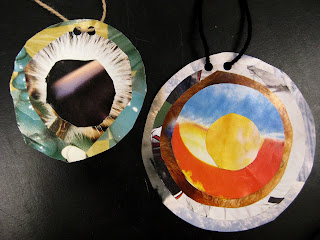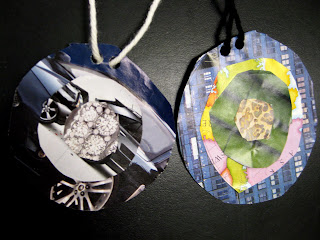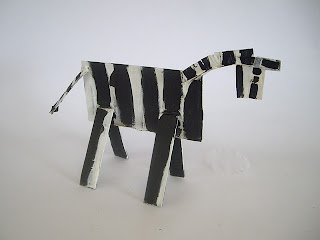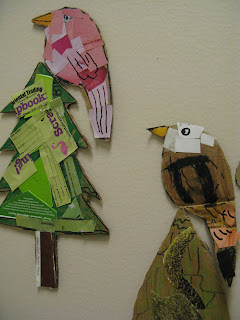WHERE CAN WE FIND THIS MATERIAL?
At Home:
- Boxes for food items such as cereal, pasta, sodas, crackers, cookies, frozen dinners, fruit snacks, popsicles, tea, baking packages, etc. Make sure that any item containing food is free of all residues, crumbs, etc. in order to avoid problems with allergies and bugs!
- Boxes for household items such as light bulbs, toothpaste, band-aides, beauty products, etc.
- Used moving or shipping boxes
- Shoe boxes, hatboxes, etc.
(I'll do a separate post about cardboard rolls!)
At Work:
- Boxes for office supplies such as paper clips, scotch tape, pencils, ink cartridges, etc.
- Boxes for reams of paper (these make GREAT storage boxes, and the lids are excellent supply trays)

In the Community:
- Grocery stores - lots of boxes for transporting food!
- Coffee shops - those little cardboard sleeves that keep your drinks warm are just begging to be reused after the drink has been guzzled down!
- There are infinite possibilities!!! So many things get thrown away, so look around!
HOW DO WE PREPARE THIS MATERIAL?
For thin cardboard (such as cereal boxes):
- Remove any inner bags, food particles, etc.
- Undo the top and bottom flaps so that the box can be flattened along it's side seams. (Do not crush or force box to flatten it - warping or creasing the flat surfaces of the box makes it way less useful as an art material.)
For packing/shipping boxes:
- Have an adult remove any staples or other sharp binding materials that may have been used to hold the box together.
- Remove anything left inside the box such as packing papers or peanuts.
- Remove any leftover tape, papers that were attached to the surface of the box, etc.
- Undo the binding so that the box can be flattened (do not crush or force box to flatten it - warping the flat surfaces of the box makes it way less useful as an art material)
HOW DO WE STORE THIS MATERIAL?
Depends on a couple factors: how much of the material are you collecting? what type(s) of cardboard are you collecting? what do you plan to do with it? There are lots of methods that can work; here's what we found effective:

For thin cardboard:
- Create a storage system that allows you to sort unused, flattened boxes by color. You will need a clear storage bin, box, shelf, or file drawer for the following colors: red, orange, yellow/gold, green, blue, purple, black/grey/silver, and rainbow.
- For storing thin cardboard boxes that have been cut up into smaller shapes use either one large, clear storage bin or many small, clear storage bins; the large bin can hold assorted colors, or the small bins can be used to hold separate colors.
Considerations: Students looking for boxes with specific colors and designs will find it helpful to be able to flip through flattened boxes as if they searching through a file drawer. Stacking boxes on top of one another, though convenient, often leads to big messes when students are in a rush. Also, it's good to have one box for leftover scraps of all colors so that students do not put small pieces back into the main boxes (which also leads to a big mess!)
For thick cardboard -
- The best options are either a wide shelf for stacking boxes or a vertical shelving system for standing boxes upright.
- Boxes should be flattened in order to take up the least amount of space.
- Keep in mind fire safety regulations in your building. Remember that cardboard is flammable and can be a fire hazard if not properly stored!
- Considerations: When stacking flattened boxes on top of one another, stack biggest on the bottom to smallest on top - otherwise the stack could topple. The same works well for vertical stacking, so that all boxes are easy to find. Also, flattened boxes that are stored vertically can sometimes bend, warp, or become worn at the edges.

WHAT OTHER ART MATERIALS ARE COMPATIBLE?
Acrylic paint - adheres nicely to cardboard; be careful not to water-down paint, a thick layer is needed to cover print or color already on the box
Spray Paint
Exacto and Utility Knives - blade will need to be replaced somewhat frequently for smooth cuts
Duct Tape & Packing Tape
Hot Glue - for attaching heavy items
Elmer's Glue - for attaching lightweight items like paper, buttons, soda tabs (some heavier items like bottle caps work for this too - you just have go put on a thick layer of glue and let it dry for a long time!)
Permanent Markers
Heavy-Duty Paper Cutter (as long as it specifies capability for cutting cardboard) - works well to quickly cut thin cardboard
Kids Scissors - for thin cardboard only
WHAT MATERIALS ARE NOT COMPATIBLE?
Washable Markers - will not stick to the surface of glossy cardboard; colors do not show up well on colored surface.
Watercolor Paint - will not stick to glossy surface; colors do not show up well on colored surface; water causes cardboard to warp or disintegrate.
Kids Scissors - do not work well on thick cardboard (like that of a moving box); using these to cut thick cardboard can cause the scissors to become dull and loose.
Glue sticks - generally, glue sticks do not work well with heavier, thicker materials like cardboard.
Masking Tape and Scotch tape - both either do not have strong enough adhesive to hold onto cardboard
HOW CAN WE USE THIS MATERIAL?
Here are just some of the ideas and processes we implemented in the art room last year:
Classroom Tools:
Storage - this one's pretty obvious, but cardboard can be really helpful for art teachers on a tight budget looking for ways to store supplies!
Recycling Bins - We use the boxes that reams of paper come in to hold recycled paper scraps leftover from art units. The box can then be taken directly to the recycling bin outside!
Protective Work Surface - Flatten large cardboard boxes and lay them on the table or floor to protect from messy materials such as paints and permanent markers or to protect from sharp materials like exacto knives and carving tools.
Drawing Boards - When I run out of clipboards I like to use firm, thick, flat cardboard cut into rectangles. Sometimes my students prefer them, since they allow for bigger sheets of paper. And when you're done with them, you can use them as bases for collages or sculptures.
Art Supplies:
































